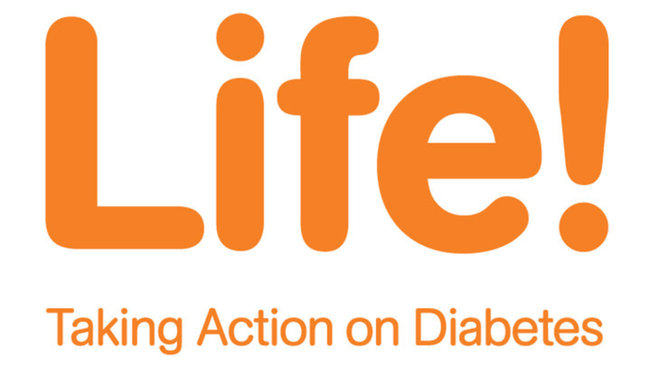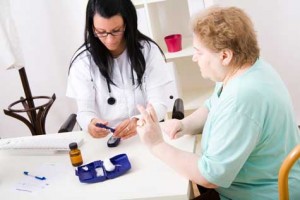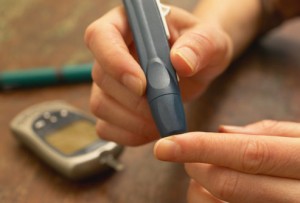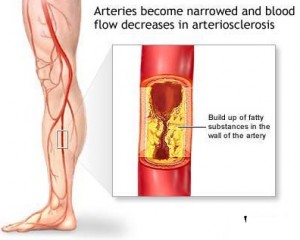Almost twenty-one million people in the US are living with diabetes and an estimated 6.2 million of these people don’t know that they have diabetes because they are undiagnosed.People with diabetes, on average, have medical expenditures that are 2.3 times higher than non-diabetics, according to the American Diabetes Association. Another study in Population Health Management estimates that diabetes is costing our nation $218 billion dollars in health care every year. Yet, most diabetes cases are preventable or reversible through exercise, weight loss, and healthy living.
I find myself wondering. What if the 6.2 million people who were undiagnosed knew they had diabetes? Or the estimated 57 million Americans with Pre-Diabetes were educated on how they could mange their health and avoid becoming a Type 2 Diabetic?
Being diagnosed as Pre-Diabetic does not mean that Type 2 diabetes is inevitable. If you lose weight and increase your physical activity, you can prevent or delay diabetes and even return your blood glucose levels to normal (ACSM 2006). (See sidebar for diabetes terms defined)
This is a very important point that many people do not understand – if you exercise and lose weight you can prevent or delay diabetes.
Do you know the signs of diabetes?Take a look around you. Do you see any signs of diabetes in your friends and family right now? (See sidebar for common signs of diabetes) It is very possible that there are people that are diabetic (or will become diabetic) around you every day. The Center for Disease Control and Prevention estimates that one in three Americans may develop diabetes in their lifetime. Those statistics are staggering and PREVENTABLE for most.
What about Type 2 diabetics that have been diagnosed? What if we educated them that through diet and exercise they could reduce their medication or eliminate it? What would this do for our health care crisis? I know that we’d first have to break through many myths, magic solutions, and limiting beliefs. The pharmaceutical companies won’t be happy with me letting this secret out either. But, what the heck, our health care system is in a crisis! Our Nation is sick! There, I said it. So let’s get down to the business of taking some personal responsibility for our health.
Many of you who are trying to understand diabetes and take responsibility for your health immediately have several questions:
- Should you cut out sugar?
- Is your weight putting you at risk?
- If you are skinny, you don’t have to worry, right?
- Can exercise and diet really help YOU?
- How do I control blood sugar levels?
And then there are the issues that you might not even know to ask about:
- Having diabetes for more than five years can increase your likelihood of developing cardiovascular disease
- Regular exercise can make you more sensitive to insulin, which can reduce medication dosages
First, let’s talk about insulin, the prime medication that keeps diabetics functioning and then you can see the answers clearly to your questions.
How does insulin work? Insulin is the main hormone that controls the entry of blood sugar from the blood stream into the cells of the body to be used as energy. How does exercise influence the insulin hormone? Exercise has an insulin-like effect on the body. When exercising, your muscles require a steady flow of sugar to keep contracting and keep you moving. Exercise increases the rate at which your muscles take up the sugar from your blood stream; so exercise acts the same as insulin by emptying the excess sugar in your blood stream into your muscles. This action, therefore, lowers your blood sugar. One twenty minute walk a day can lower glucose levels by twenty points.
Here is a great example to explain insulin’s function in your body. Think of insulin as a bus for a moment. Glucose (sugar) is the passenger. There are two types of diabetics. Type 1 diabetics manufacture no insulin (or have no bus), which, according to the Center for Disease Control, is 5% – 10% of all diagnosed cases. The second type (Type 2), have insulin resistance, which means the bus is there, but it is not picking up passengers and, there are less buses running the route. According to the Center for Disease Control, Type 2 diabetes accounts for 90%-95% of all diagnosed cases.
When you exercise, your muscles work harder than usual and require more fuel than usual; so your muscles send out their own buses to pick up the sugar in the bloodstream and carry it back to the muscles. Working muscles take over for insulin and (for Type 2 diabetics) they can even show the buses (insulin) how to work again (pick up passengers).
Exercising has many benefits for a diabetic. It increases glucose uptake by the cells, improves insulin sensitivity by improving glucose metabolism and reduces the risk of cardiovascular disease. Reduction of blood glucose levels improves insulin sensitivity by making it more effective. Exercise may reduce dosage requirements or need for medication and improve the ability to lose and/ or maintain body weight if combined with an intuitive diet. (See sidebar for Safe Exercise Check List)
There are many popular myths about diabetes. Here are a few that I hear often.
Myth #1 – Diabetics can’t eat sugar or sweets and the only reason they have diabetes is because they ate too much sugar. Yes, simple carbohydrates or sweets do raise your blood glucose levels but if you eat them in moderation and make them part of your meal plan, you can safely eat an occasional sweet
Myth #2 – If I’m skinny I’m fine. Diabetes is only a disease that obese people get.
Not completely true, 20% of people with Type 2 Diabetes are slim. Yes, being obese does put you at risk for Type 2 Diabetes, high blood pressure and high cholesterol. The key thing to remember is that there is not an atypical “diabetes” body type, genetic trait, race, age or gender. Type 2 diabetes is caused by lifestyle choices and diabetes is a disease to take seriously.
Myth #3 – There is no natural remedy for Diabetes. If I take insulin or insulin sensitivity drugs I can continue with my same lifestyle choices and be alright. Well there is a natural remedy, it is called exercise and balanced eating. You can keep a tight control on diabetes by monitoring your glucose levels, combining exercise with balanced eating, or use medication.
Myth #4 – Well I’m only borderline and 170 mg/dl blood sugar reading is normal for me. You may feel normal being a diabetic but high glucose levels are not safe. There is no such thing as borderline. You either are a diabetic or you are not a diabetic. This is a serious disease that requires you to take personal responsibility for your body. There is serious health complications associated with diabetes, especially when you are stressing your body with high blood sugar levels. You have to start to make lifestyle changes so that you can live a quality life over the long term.
Myth #5 – Exercise! What can that do for me? Blah! Blah! Healthy Lifestyle Blah! Yeah, Yeah, I know. The American Diabetic Association recommends 150 minutes of exercise a week. This is exercise of 20-60 minutes, in continuous sessions, 3-5 times a week. The Diabetes Prevention Study revealed that exercising for a total of two hours a week can reduce the risk of developing diabetes by 50%, that can be as little as 20 minutes, 6 days a week. Take a short, ten minute walk before and after work and you can prevent diabetes or lower your glucose levels.
The fact is, over 90% of diabetes cases are preventable and can be maintained with some natural remedies such as exercising, healthy eating, and/or combined with low doses of medication without tapping into our health care system to the tune of $218 billion. Start gradually and exercise a little everyday until you build up to the recommended guidelines. Eat a balanced, healthy diet and lose the all or nothing approach. Get educated about your disease, determine what your beliefs are about diabetes and make lifestyle changes starting today. (See sidebar Want to Learn More)
Diabetes is serious but you can do something about it!
Side Bars:
Diabetes Terms Defined
Type 1 = Auto immune disease that destroys insulin producing cells in the pancreas. The body cannot manufacture its own insulin because the beta cells of the pancreas that are responsible for insulin production are destroyed. About 5-10% of all diagnosed cases (CDC 2005)
Type 2 = body loses its sensitivity to insulin so the body’s cells are unable to utilize insulin properly (also knows as insulin resistance or adult onset diabetes). About 90% – 95% of all diagnosed cases (CDC 2005)
Pre-Diabetes = If you have a fasting plasma glucose test (FPG) and your levels are 100 mg/dl to 125 mg/dl you are diagnosed as showing signs of becoming a diabetic unless you make some lifestyle changes
Gestational Diabetes = When pregnancy hormones interfere with the mothers insulin, causing glucose levels to rise. This is a form of insulin resistance that in most cases ends with the birth of the child.
Metabolic Syndrome = A combination of medical disorders that increases the risk factors of developing cardiovascular disease, obesity, hypertension, low high-density lipoprotein (HDL), high cholesterol levels and elevated plasma triglyceride levels.
Hypoglycemic = abnormally low blood sugar levels which could be caused by excessive insulin, or your diet. Signs would be: trembling or shakiness, nervousness, rapid heart beat, increased sweating, headache, impaired concentration or attentiveness, unconsciousness and coma
Hyperglycemic = abnormally high blood sugar levels. Signs would be: frequent urination, great thirst, nausea, abdominal pain, dry skin, disorientation, labored breathing, and drowsiness.
Do you know the signs of diabetes? Some very telltale signs include:
- frequent thirst, hunger and urination
- weight loss
- fatigue
- crankiness
- frequent infections
- blurred vision
- cuts/ bruises that are slow to heal
- tingling and numbness in hands and feet
- recurring skin, gum and bladder infections
Safe Exercise Check List
- Get physician clearance before starting any exercise program
- Test your blood glucose level before exercise, immediately after exercise, and again two hours after exercise
- Follow general guidelines for a safe exercise session; warm-up, cool-down, stretch, adhere to an intensity of Type 1 (3 to 5 RPE) and Type 2 (3 to 6/7 RPE), drink plenty of water
- Wear well-fitting, well cushioned, supportive shoes
- Wear polyester or cotton polyester socks so that your feet stay dry and minimize trauma to the foot
- Avoid strenuous, high-impact or static activity unless specifically approved by your doctor
- Carry a carbohydrate snack with you of 10-15 grams of carbohydrate
- Wear identification that tells others you have diabetes in case of a hypoglycemic response
- Know and monitor signs of exercise induced hypoglycemia
- Do not exercise if <90 mg/dl or >250 mg/ dl blood glucose levels or if you have ketones in your urine
- If you have autonomic neuropathy, peripheral neuropathy, neuropathy, retinopathy or any other related conditions to diabetes, you must get a doctors approval before starting an exercise program. These conditions require specific and strict guidelines.
- Exercise with a partner until you know your response to exercise
- Always check your feet before and after exercise for lesions
- Drink plenty of water. A good rule is to take a mouthful or two at least every fifteen minutes
http://ezinearticles.com/?expert=Kimberly_Searl



